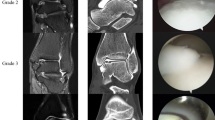Abstract
The purpose of the present study was to evaluate the accuracy of MRI compared with arthroscopy in staging of osteochondral lesions of the talus (OLTs). The authors prospectively investigated 50 patients (52 cases) who had undergone both MRI and ankle arthroscopy for OLTs. The 30 males (32 ankles) and 20 females (20 ankles) had an average age of 43 years (range 19–64 years). The correlations between MRI and arthroscopic stagings were also investigated. Preoperative MRI resulted in 7 stage I, 11 stage II, 25 stage III, and 9 stage IV lesions, and ankle arthroscopic findings in 3 stage I, 5 stage II, 35 stage III, and 9 stage IV lesions. No stage V lesion was encountered. A comparison of MRI and arthroscopic stagings revealed that MRI had an accuracy of 81% (42 of 52) for staging of OLTs. MRI correctly staged 3 of 7 stage I lesions, 5 of 11 stage II, 25 of 25 stage III, and 9 of 9 stage IV lesions. Ten mismatched cases were of arthroscopic stage III lesions, which MRI classified as four stage I lesions and six stage II lesions. Thus, MRI staging tended to understate lesion severity. We re-reviewed the ten MR images of the mismatching cases to identify reasons for these mismatches, and subchondral edema was found in six cases. The authors conclude that MRI has accuracy of 81% in staging of OLTs, however, MRI had some limitation in correct staging isolated cartilage lesions of OLTs, especially combined with subchondral edema.





Similar content being viewed by others
References
Berndt AL, Harty M (1959) Transchondral fractures (osteochondritis dissecans) of the talus. J Bone Joint Surg Am 41:988–1020
Alexander AH, Lichtman DM (1980) Surgical treatment of transchondral talar-dome fractures (osteochondritis dissecans). Long-term follow-up. J Bone Joint Surg Am 62:646–652
Dipaola JD, Nelson DW, Colville MR (1991) Characterizing osteochondral lesions by magnetic resonance imaging. Arthroscopy 7:101–104
Pritsch M, Horoshovski H, Farine I (1986) Arthroscopic treatment of osteochondral lesions of the talus. J Bone Joint Surg Am 68:862–865
Mesgarzadeh M, Sapega AA, Bonakdarpour A, Revesz G, Moyer RA, Maurer AH, Alburger PD (1987) Osteochondritis dissecans: analysis of mechanical stability with radiography, scintigraphy, and MR imaging. Radiology 165:775–780
O’Connor MA, Palaniappan M, Khan N, Bruce CE (2002) Osteochondritis dissecans of the knee in children. A comparison of MRI and arthroscopic findings. J Bone Joint Surg Br 84:258–262
Mintz DN, Tashjian GS, Connell DA, Deland JT, O’Malley M, Potter HG (2003) Osteochondral lesions of the talus: a new magnetic resonance grading system with arthroscopic correlation. Arthroscopy 19:353–359
Schimmer RC, Dick W, Hintermann B (2001) The role of ankle arthroscopy in the treatment strategies of osteochondritis dissecans lesions of the talus. Foot Ankle Int 22:895–900
Cheng MS, Ferkel RD, Applegate GR (1995) Osteochondral lesions of the talus: a radiologic and surgical comparison. Presented at the Annual Meeting of the Academy of Orthropaedic Surgeons, New Orleans, LA, 16–21 February
Bohndorf K (1998) Osteochondritis (osteochondrosis) dissecans: a review and new MRI classification. Eur Radiol 8:103–112
De Smet AA, Fisher DR, Burnstein MI, Graf BK, Lange RH (1990) Value of MR imaging in staging osteochondral lesions of the talus (osteochondritis dissecans): results in 14 patients. AJR Am J Roentgenol 154:555–558
De Smet AA, Ilahi OA, Graf BK (1996) Reassessment of the MR criteria for stability of osteochondritis dissecans in the knee and ankle. Skeletal Radiol 25:159–163
Schäfer D, Hintermann B (1996) Arthroscopic assessment of the chronic unstable ankle joint. Knee Surg Sports Traumatol Arthrosc 4:48–52
Tan TC, Wilcox DM, Frank L, Shih C, Trudell DJ, Sartoris DJ, Resnick D (1996) MR imaging of articular cartilage in the ankle: comparison of available imaging sequences and methods of measurement in cadavers. Skeletal Radiol 25:749–755
Rubin DA, Harner CD, Costello JM (2000) Treatable chondral injuries in the knee: frequency of associated focal subchondral edema. AJR Am J Roentgenol 174:1099–1106
Kramer J, Stiglbauer R, Engel A, Prayer L, Imhof H (1992) MR contrast arthrography (MRA) in osteochondrosis dissecans. J Comput Assist Tomogr 16:254–260
Kramer J, Recht MP, Imhof H, Stiglbaüer R, Engel A (1994) Postcontrast MR arthrography in assessment of cartilage lesions. J Comput Assist Tomogr 18:218–224
Author information
Authors and Affiliations
Corresponding author
Rights and permissions
About this article
Cite this article
Lee, KB., Bai, LB., Park, JG. et al. A comparison of arthroscopic and MRI findings in staging of osteochondral lesions of the talus. Knee Surg Sports Traumatol Arthr 16, 1047–1051 (2008). https://doi.org/10.1007/s00167-008-0607-x
Received:
Accepted:
Published:
Issue Date:
DOI: https://doi.org/10.1007/s00167-008-0607-x




